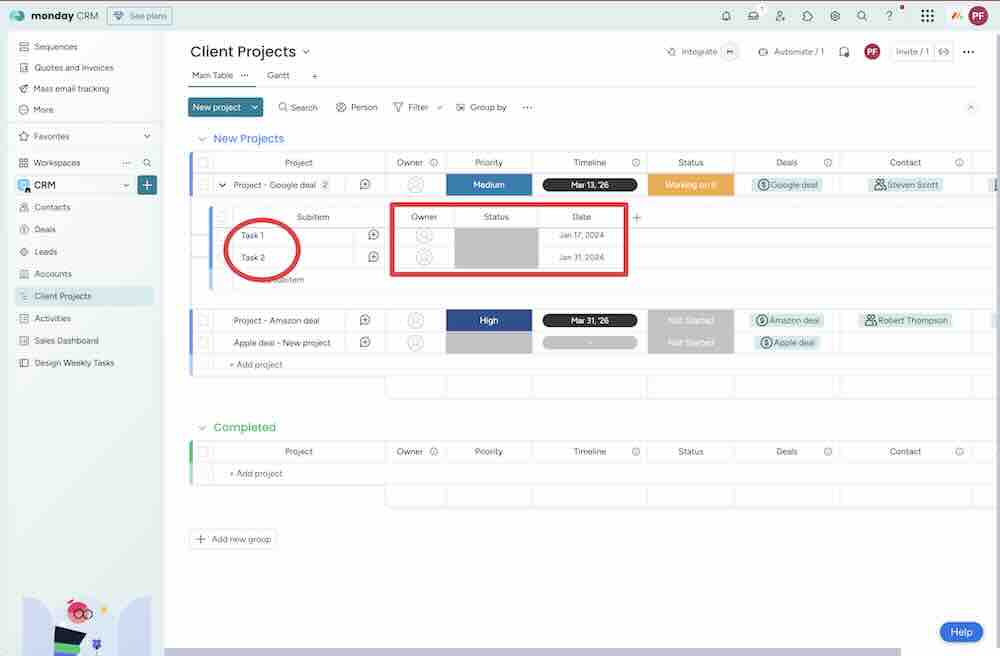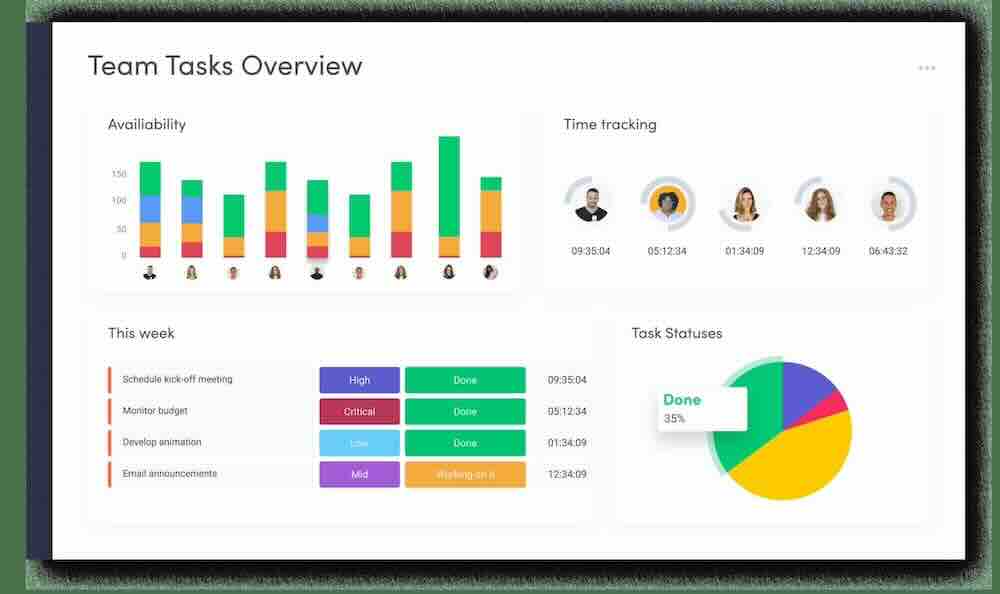So, you’re diving into Monday CRM and ready to get organized? That’s awesome! But let’s talk about something nobody really mentions upfront: task management. Or, should I say, the lack of task management right out of the box. It’s not terrible, but it’s also not great!
The Truth About Task Management in Monday CRM
Initial Impressions
Let’s start with a fresh slate. Imagine signing up for a brand new Monday CRM free trial. What do you see? Well, typically you’ll see a bunch of boards already set up. These boards might include contacts, deals, leads, accounts, and client projects. It’s like Monday CRM is trying to be helpful. Monday CRM does give you some customization during onboarding, so your setup might look a little different from mine, but don’t worry about that too much. We’re all in the same boat.
The Missing Piece: Task Management

Now, here’s the kicker. Where’s the task management? You might notice something’s missing. You have all these boards, but nothing really screams, “Hey, let’s manage some tasks!”
Take the “Client Projects” board, for example. You can add tasks as sub-items within each project. Each sub-item can have a status, a due date, and someone assigned to it. But let’s be real, that’s pretty basic.
Why not just use sub-items, then? Sub-items are more limited than items in Monday. Generally, you’re better off using items whenever you can.
Think of it this way: items in Monday CRM are like full-fledged entities. They can have all sorts of columns, automations, and connections. Sub-items, on the other hand, are kind of like afterthoughts. They’re stuck within their parent item and don’t have as much flexibility. If you haven’t worked with items and sub-items before, items are individual entries on your board, and sub-items are entries that live inside those items.
The Smarter Approach: Connecting Projects to Tasks
So, how do you manage tasks effectively in Monday CRM? Instead of relying on those limiting sub-items, create a separate board just for tasks! Then, connect your projects to your tasks.
By building a relationship between project items and task items, you get the best of both worlds. You can manage your projects and your tasks independently, while still keeping them linked together.
Building Your Own Task Management System
Okay, so the default setup isn’t cutting it. What’s next? How do you actually build a decent Monday CRM Task Management system?
Starting with a Template
One of the easiest ways to get started is by using a template. Monday CRM has a bunch of pre-built templates that you can customize to your needs.
To add a board from a template, click the plus button in your workspace, select “add to workspace,” and then choose “start with template.” This will take you to the automation center.
The “Design Weekly Tasks” Template: A Good Starting Point
In the automation center, search for “task.” You might be surprised to find some hidden gems. Even something like the “Design Weekly Tasks” template can be a solid starting point for general task management.
Don’t let the “design” part fool you. This template has a good structure for managing any kind of task. It includes pre-built boards and views, which can save you a lot of time and effort.
Exploring the Template’s Features
Once you’ve added the template, take a look around. The default view might be set to “Asset Cards,” but you’ll probably want to switch to the main table view to see everything.
You can reorder the board views by clicking and dragging them, but this is a newer feature in Monday CRM, so things might look a little different.
Key Columns and Customization
Now, let’s talk about the columns in the template. Here are some key ones you’ll likely see:
- Assignee: This is the person responsible for the task. If you’re not a design team, you might want to rename this to “Owner” or something more general.
- Priority: How important is this task?
- Status: Where is this task in the process (e.g., “To Do,” “In Progress,” “Done”)?
- Due Date: When is this task due?
- Description: A brief explanation of the task.
- Asset Files and Brief ID: These might be specific to design tasks, so feel free to customize or remove them.
You might also see a column called “Design Idea” or something similar. This is actually an “Item ID” column that’s been renamed. Every item in Monday CRM has a unique ID number. You can delete this column if you don’t need it, and you can always add it back later. The numbers won’t change.
Automations: Basic but Helpful
This template comes with a few basic automations to help you get started.
- Notification: You’ll get a notification the day before a task is due.
- Status Change: Subscribers will be notified when the status of a task changes to “Waiting to Review.”
- Move to Done: When a task is marked as “Done,” it will automatically be moved to the “Done” group.
These automations are a good starting point, but they’re pretty basic. You’ll probably want to add more automations to customize your task management system.
Limitations and Considerations
Keep in mind this template is a starting point. It has limitations.
For example, there’s no recurring task functionality. If you have tasks that need to be done regularly, you’ll have to create them manually or find a workaround.
There’s also no automatic way to move tasks to different groups based on their due dates. You’ll have to do that manually as well.
To really unlock the power of Monday CRM for task management, you’ll need to add more automations and customize the template to your specific needs.
Level Up Your Monday CRM Task Management
The Path to a Powerful Task Management System
So, where do you go from here? The template is a good start, but it’s not the end of the road.
If you’re serious about task management, you might want to consider building a board from scratch with custom features. This will give you more control over how your tasks are managed and allow you to create a system that perfectly fits your needs.
Recap of the Current Situation
Let’s be honest, Monday CRM Task Management is almost non-existent out of the box. And even if you add a Template like Design Weekly Tasks, Task Management functionality is still extremely basic.
So, chances are, you are going to want to build a more effective Task Management setup – and, luckily for you, I can help. I am working on a series of super short videos that will walk you step-by-step through how to set up the most amazing Task Management Board in Monday CRM that you have (n)ever seen. And the best part? I’m looking for Beta Testers to give me feedback on these videos and not only will you get complete access for free, you even get to chat with me to discuss any questions or feedback you might have.
Disclaimer
Features and functionalities in Monday CRM can change over time, so this blog post reflects my experience.
What are your thoughts?
What are your favorite Monday CRM task management tips? Share them in the comments below!
If you want to know more about advanced Monday CRM setups, subscribe to the blog.
You can visit the Monday CRM website to learn more.
Conclusion
While Monday CRM doesn’t offer a perfect task management solution right out of the box, it provides the tools you need to build your own. By starting with a template and customizing it to your specific needs, you can create a powerful task management system that helps you stay organized and productive. It might take some effort, but it’s worth it in the end!

